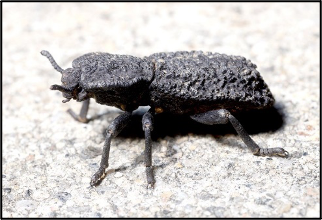Diabolical Ironclad Beetle - Engineering
This oddly named beetle lives under rocks and in trees throughout southwest U.S. and Mexico. It has the impressive ability to withstand crushing forces. If run over by a car tire, the beetle continues on its way. A better name for this inch-long insect might simply be the survivor beetle.
The beetle has an unusual protective outer shell or exoskeleton. Separate parts are made of composite layers, like plywood. The shell sections also interlock like the “loops” and “sockets” of jigsaw puzzle pieces. This arrangement allows surface flexing and the distribution of any applied force, similar to the high strength of an eggshell under compression along its length.
Researchers first noticed the beetle’s armor strength when attempting to pin it to a display board. The result was a bent pin, and a power drill finally penetrated the shell. The photo of the inch-long insect is a Getty image.
Evolutionists suggest that the tough beetle evolved its extreme crush resistance for protection from predators or large rocks. Such explanations are imaginative but unconvincing. Instead, this beetle illustrates the varieties of design surrounding us in nature, dating from the time of creation.
As with all surprises in nature, the question arises, “What might this feature be good for?” In the case of the tough beetle, there is insight for the joining dissimilar materials. Such joints are often the weak link in construction, whether using glue, welds or bolts. Applications include stronger and safer vehicles, aircraft and military hardware.
The ironclad beetle illustrates biomimicry, the discovery and application of useful ideas, embedded in nature by the Creator.

Rivera, Jesus, et al., Toughening mechanisms of the elytra of the diabolical ironclad beetle, Nature, Volume 586, Oct 21, 2020, pp. 543-548.